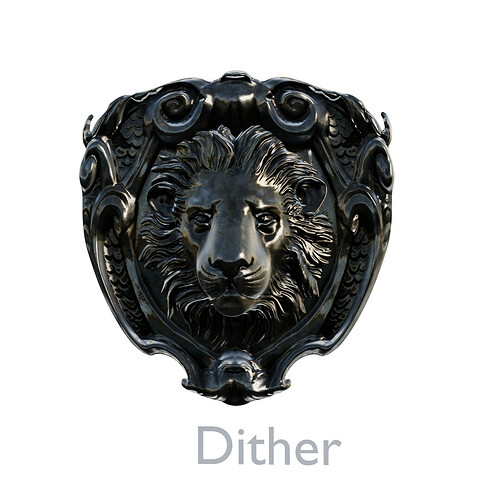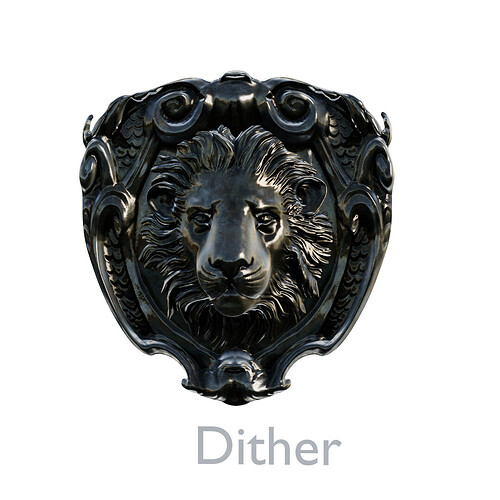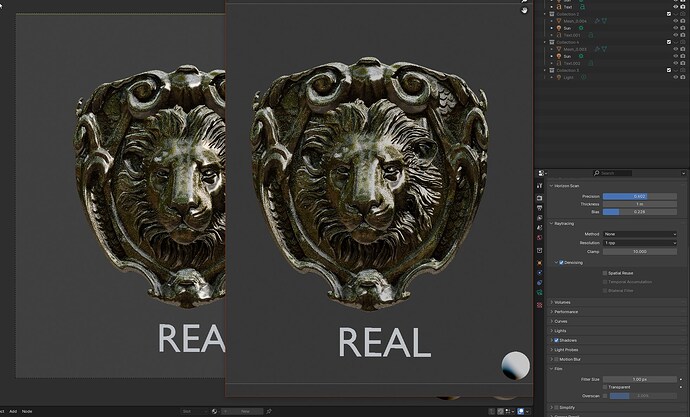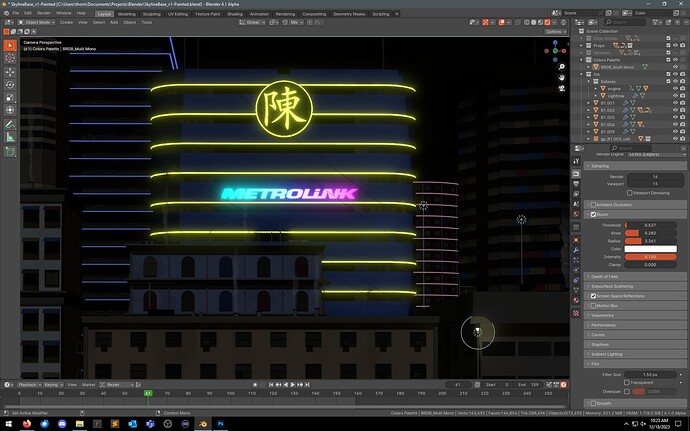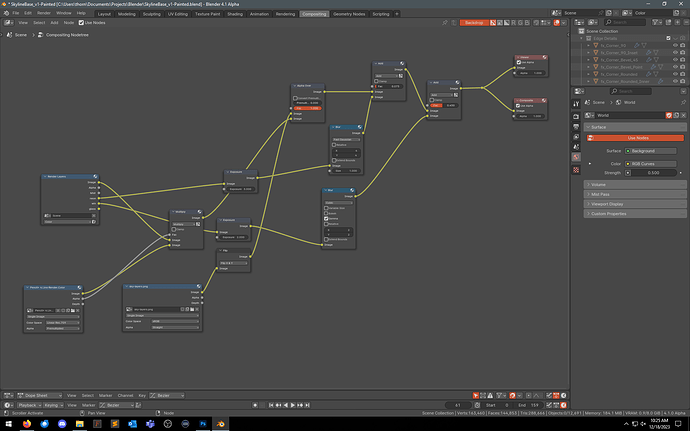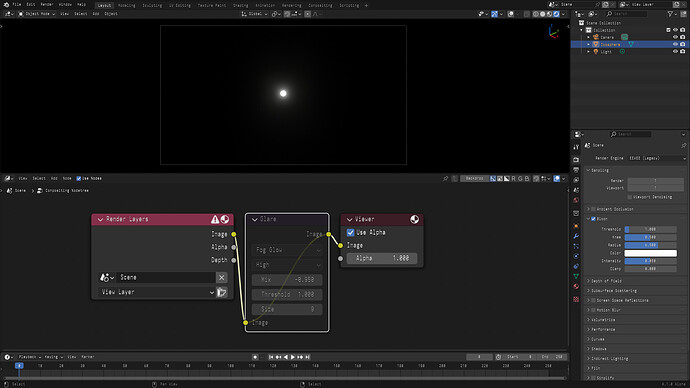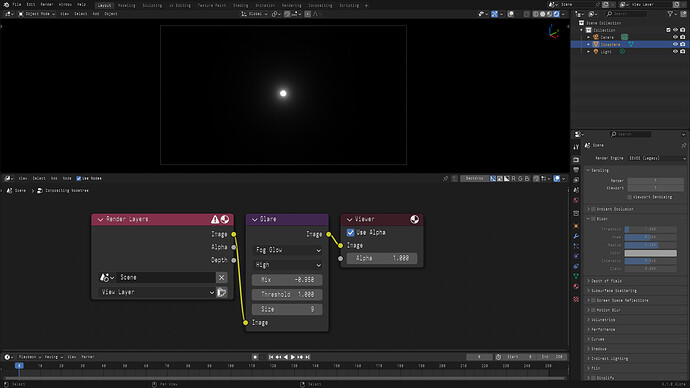Why is there such a difference in reflections ![]() ? Imgur: The magic of the Internet
? Imgur: The magic of the Internet
EEVEE NEXT reflections are huge different from the EEVEE Legacy
I guess that comes down to screen-space effects.
ScreenSpace tracing enabled:
ScreenSpace Tracing disabled:
Anyway.
Viev>Viewport Render Image seems to ignore sample render settings and does not look like viewport.
It seems lake its rendered with single sample.
@fclem
alpha blended and alpha clipped material options are not available in eevee next, are they deprecated or will they return ? Its important to know for many many people , so please communicate the dev team’s decision on this subject.
Thank you
I might be wrong but after testing I think its due to denoising of raytracing effects. I hope it gets improved, make visualising car paints almost imposible.
I was assuming that there would be a new “Bloom” node with similar or better functionality than the Eevee legacy Bloom. “Glare” node is nothing even close of it! ![]()
Material blend modes have been replaced by Material Render methods. Dithered render method replaces Hashed blend mode. Blended replaces Alpha blended. Alpha clipped should be solved in the shader.
The Bloom will most likely be its own node/option in the future. What kind of limitations do you think the compositor Bloom have? Maybe share that in the compositor feedback thread.
The ones that @L0Lock mentions on the screenshot.
Glare has no control except of the threshold and size doesn’t go further than 9 pixels.
Bloom has all those settings and we can have it in any radius and color we want.
Basic question the new implementation of global illumination for eevee-next are been based on surfels (Surfels GI) i know, but is a GI Baked only and if i interract with an elements i need to re-bake it that’s right ?
So isn’t a GI based on realtime but on Baked GI ?!
Because in the new eevee i don’t the see the feature for have a realtime interaction without rebake manually everytime (Like in legacy eevee with auto-bake) So… is it planned to use Probe in real time ?!
Or i goes wrong, and is to surfels to make this job ?
The current bloom can present as a preview effect:
…which the Realtime Compositor can not do
… if you have final rendering node setup that Realtime can not display.
(Multi EXR output node not present here, not relevant.)
Before “sorry, the realtime compositor doesn’t support all features at this time” - yes, I know that. That’s why I never turn it on, because it’s useless with this type of pass output.
One might note that my nodes don’t contain a “bloom pass” - that’s correct, I’m doing the effect in post on a per-pass basis. But the needs of final output is different than viewport preview. So, taking bloom out of Eevee and giving it to the Compositor team to worry about (if and when they do) means I’ll have no bloom preview now, at all.
(Compositor) Glare is slow, (viewport) Bloom is instant?
Perhaps we misunderstood each other, I thought we were specifically comparing the compositor bloom (GPU version of Fog Glow) with EEVEE bloom.
Your stated concerns are of course valid and will be handled, hopefully soon enough.
I am for bloom being a compositor only effect but there are currently drawbacks:
- Difference between viewport and final render, huge pain point for me since using GPU for final renders is still Alpha-only.
- Fog glow is slow
- As others said, lack of control and very small raduys, while many people prefer the large radius Legacy bloom has.
- Issues when working with multiple passes
The best way to go about it IMO would probably be just turning EEVEE-Legacy bloom into it’s own compositor node for 4.1, I imagine the main thing holding that back would be having to port it to CPU?
A potential workaround for for multipass workflows would be to make it so you can make the compositor output Viewport or Render only (like how you can select between EEVEE and Cycles in materials), but that’s not exactly for this thread.
The best way to go about it, is to leave it alone and let it continue to exist as it is.
The way bloom currently works allows the artist to have a view-preview idea, of what works and doesn’t - in the same way that “viewport” vs “render” might be different for subdivision.
If one wishes to use bloom/glare in a compositing method, you can already do this. The nodes are already there. Yes, they produce a different visual result - but I’m not arguing that point, as it goes to “sorry people don’t like the current filter.”
Having a Bloom node is totally fine as long it behaves and allows to do the same or better than Eevee-legacy… and as mentioned needs to give that WYSIWYG preview. I personally would just prefer to have it were it has been. ![]() It’s a tool that one wants to have on top of the table all the time.
It’s a tool that one wants to have on top of the table all the time.
“Fog Glow”, from the compositor glare node, doesn’t make the cut at all for an Eevee user.
@OmarEmaraDev I apologize, just to make sure that indeed this isn’t a big misunderstanding…
![]() you mention:
you mention:
“compositor bloom (GPU version of Fog Glow)”
Is this something in the works!? Do we (normal artists) can see it on recent builds?
Or is just the old “Fog Glow” from the glare node on the compositor?
Could you perhaps take a screenshot if it’s something else? ![]()
The Fog Glow option in the Viewport/GPU Compositor is essentially the same as the Bloom option in EEVEE, albeit being higher in quality. It has nothing to do with the slow/limited Fog Glow option in the CPU compositor.
Here is a comparison between EEVEE Bloom and Viewport Compositor Fog Glow, using equivalent settings. Notice that the Mix in the node should be computed from EEVEE Intensity using the relation:
Mix = -1 + Intensity
You will notice that they both give similar results. The Compositor one is even higher quality. The only limitation is that we don’t have a Knee parameter which is used to control the falloff of the highlights, and I don’t think it has many use cases to be honest.
Now, the fact that Fog Glow in Viewport/GPU compositor is different from the CPU compositor is a bug and should be solved by 1) Adding an additional option specifically for Bloom and 2) Actually implement the Fog Glow option for the GPU. Why haven’t we done that already? For two reasons:
- Implementing actual Fog Glow is difficult and will take time. So we opted to temporarily add Bloom as an alternative implementation for you guys to play with in the meantime. Why not add Bloom as a separate option at this point? Due to the next point.
- I do not want to commit to a new option at the moment and face future difficult decisions with regards to breaking compatibility and the like.
So I am asking for two things:
- Feedback on the effects that were possible using EEVEE Bloom but are not possible using GPU Fog Glow.
- Some patience until we properly support all modes of glare you need.

i would like the bloom to go back where it was in the render tab, but since it seems like a no go, my vote goes for a full blown bloom node.
the glare node can continue to be the good old glare node ![]()
(if anyone wondering, its in the material tab in properties , not in the shader editor sidebar (yet).)
Alpha blended mode also defaults to dithering though if more than one alpha blended materials are in front of each other(think multiple- nebula/dust/smoke image planes) , it can also create halos around sharp alpha seperations, and while blended mode finally works with GP, it will also switch to dithering if in front of each other (the only reason it works probably) .
Edit: another standard scenario would be a multilayered background illustration seperated onto multiple image planes . Dithering noise will go through the roof.
This dithering cant even be come by with 4092 or more samples depending on the type of shader. (smoke , fire and other halftransparent materials are more suspect but so are the edges of textures with strong alpha seperation).
and while you might get lucky with a very simple scene and 500+ samples of samples , it wont work on any scene remotly complex (even with unlimited sampling).
(one way to eleviate it a bit is to use as few objects as possible, and composit the different alpha mapped textures and materials inside just one material and then use empties to animate the textures inside the image plane accordingly. But thats just a workaround with multiple problems of course)
anotehr workaround is to seperate background, midground into viewlayers and render them one by one and composite over until the number of transparent materials in a single layer get low enough for the engine to be able to handle it (seems dithering noise gets expostentially bigger with each transpartent material …
ill make a comprehensive test scene this week.
Thanks for clarification. So I’m assuming tint can be done with just mix color right? If thats the case I’m personally happy enough with node. I do not like panel and separate option for bloom, as it creates questions about how it mixes with compositing, and opens a can of worms, potential bug reports and feature requests that I think developers shouldn’t be dealing with. Unification is the way.
I also dont think adding Bloom node is good idea if its gonna do same thing that Fog Glow does, its just creating confusion in the future (although I’m thinking about option that removes Fog Glow from Glare node and it basically becomes separate node)
As for the way to implement it, if by 4.1 release Fog Glow is in the state that it is in right now, and gives different results it shouldn’t be left like that. There are three options as I can see:
- Implement Fog Glow for GPU if time is available
- Do some hacky magic that avoids rendering looking different just for that specific case
- If none of the above possible, leave Bloom panel just for time being and version it out when Fog Glow is done.
And one more feedback I’ll have on that:
- Make Fog Glow default mode for Glare node

